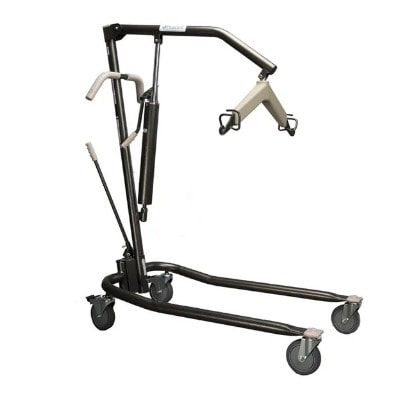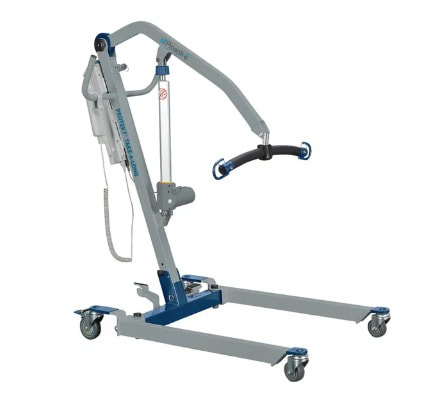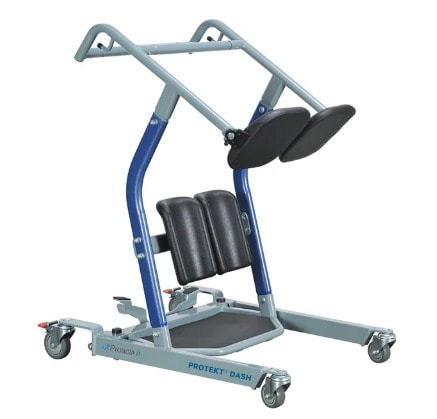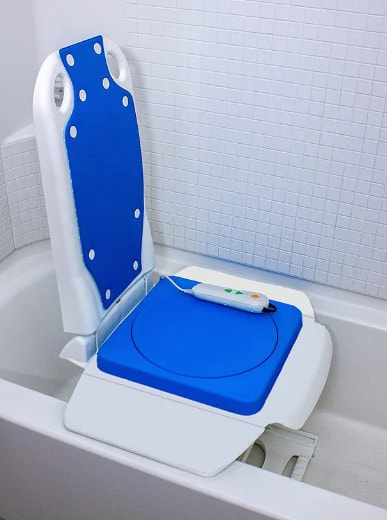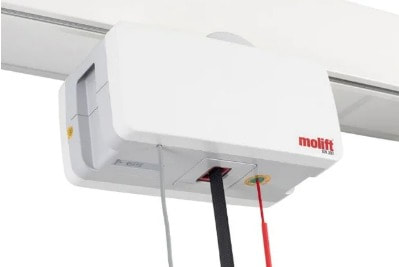|
What are patient lifts? Patient lifts are devices that use a hoist mechanism to raise and lower a patient who is attached to a sling. Patient lifts can be used for various purposes, such as moving patients from bed to wheelchair, from wheelchair to toilet, or from one surface to another. Patient lifts can improve the safety and comfort of both the caregivers and the patients by reducing the physical strain and stress involved in lifting or transferring. They can also enhance the quality and efficiency of patient care by allowing caregivers to perform lifting or transferring tasks more quickly and easily. Here are the 5 Most Common types of Patient Lifts: A Review and GuideThere are many different types of patient lifts available on the market, but the five most common ones are:
1. Hydraulic Manual Patient Lifts Hydraulic manual patient lifts are devices that use a hydraulic pump to operate the hoist mechanism. The caregiver has to manually pump a handle to raise or lower the patient. Hydraulic manual patient lifts are usually cheaper than other types of patient lifts, and they do not require any electricity or battery power to operate. However, they also require more physical effort from the caregiver, and they may not be suitable for patients who are very heavy or who need frequent lifting or transferring. Some of the benefits of hydraulic manual patient lifts are:
2. Battery powered patient lifts Battery powered patient lifts are devices that use a rechargeable battery to operate the hoist mechanism. The caregiver can use a remote control or a hand control to raise or lower the patient with the push of a button. Battery powered patient lifts are usually more expensive than hydraulic manual patient lifts, but they also require less physical effort from the caregiver, and they can provide smoother and more precise movements. However, they also depend on battery power, which means that they need to be charged regularly, and they may not work if the battery runs out. Some of the benefits of battery powered patient lifts are:
3. Sit to stand patient lifts Sit to stand patient lifts are devices that help patients who can bear some weight on their legs to stand up from a sitting position or sit down from a standing position. They are also known as stand assist lifts or stand up lifts. Sit to stand patient lifts are usually used for patients who need assistance with toileting, dressing, or transferring. They are not suitable for patients who cannot bear any weight on their legs or who have poor trunk stability. Sit to stand patient lifts are usually more expensive than other types of patient lifts, but they also provide more benefits for the patients, such as improving their circulation, muscle strength, bone density, and psychological well-being. Some of the benefits of sit to stand patient lifts are:
4. Bathtub patient lifts Bathtub patient lifts are devices that help caregivers to lift and transfer patients who need assistance with bathing. They are also known as bath lifts or tub lifts. Bathtub patient lifts are usually used for patients who have difficulty getting in or out of the bathtub, or who cannot sit comfortably in the bathtub. They are not suitable for patients who have severe balance or coordination problems, or who have open wounds or infections. Bathtub patient lifts are usually more expensive than other types of patient lifts, but they also provide more comfort and hygiene for the patients, as well as more convenience and safety for the caregivers. Some of the benefits of bathtub patient lifts are:
5. Ceiling patient lifts Ceiling patient lifts are devices that are permanently installed on the ceiling or on overhead tracks known as Free Standing Gantries. They use a motorized hoist mechanism to lift and transfer patients who are attached to a sling. Ceiling patient lifts are usually used for patients who need frequent or continuous lifting or transferring, or who have very limited space in their rooms. They are not suitable for patients who have high ceilings or who need to move between different rooms. Ceiling patient lifts are usually the most expensive type of patient lifts, but they also provide the most convenience and flexibility for the caregivers and the patients. Some of the benefits of ceiling patient lifts are:
Conclusion
In this blog post, we have explained the five most common types of patient lifts, which are hydraulic manual patient lifts, battery powered patient lifts, sit to stand patient lifts, bathtub patient lifts, and ceiling patient lifts. We have also introduced you to some of the best products that we offer at Your Medical Store for each type of patient lift. We hope that this blog post has helped you learn more about the benefits, features, and functions of each type of patient lift, and that you will be able to make an informed decision on which one suits your needs and preferences. If you have any questions or comments about this blog post, please feel free to contact us at Your Medical Store. We are always happy to hear from you and to assist you with your home medical equipment needs. Thank you for reading this blog post and have a wonderful day! Comments are closed.
|
YMSYour Medical Store Blog Posts are meant to provide you with information regarding some of the most innovative durable medical equipment products currently available for purchase in the USA. We simply want to help people who are living with disabilities and challenges. Categories
All
|
ALL ORDERS OVER $100 SHIP FREE - LOWER 48 STATES
Alaska, hawaii, us territories & international customers
additional shipping charges calculated at checkout
Accepting All Major Credit Card Payments - Safe Secure Checkout with Stripe Payment Processing or PayPal
10 Glenlake Parkway, South Tower Suite 130, Atlanta, GA 30328
Questions? No Problem, Call us @ (800)876-8143
Monday - Friday 9:00 am - 7:00 pm Eastern
Call Center is Closed on the Weekends
If we cannot answer your call, please leave us a voicemail and an agent will call you back in the order in which your message is received. You may send us your questions via email at [email protected]
Need Insurance to cover your medical product? Click the button below!
Questions? No Problem, Call us @ (800)876-8143
Monday - Friday 9:00 am - 7:00 pm Eastern
Call Center is Closed on the Weekends
If we cannot answer your call, please leave us a voicemail and an agent will call you back in the order in which your message is received. You may send us your questions via email at [email protected]
Need Insurance to cover your medical product? Click the button below!

